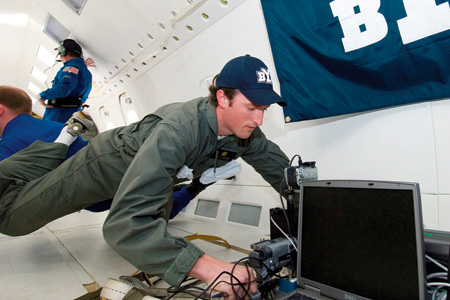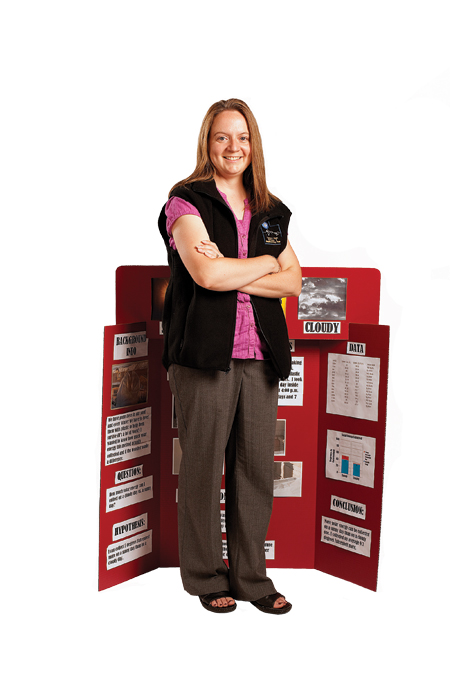 Teaching assistant Chad Nielsen is BYU’s very own Bill Nye.
Teaching assistant Chad Nielsen is BYU’s very own Bill Nye.
“Welcome to Physical Science 100!” booms V. Chad Nielsen (BA ’11) in a 265-occupancy room packed with 300 students. They and 1,150 other students are enrolled in the physical science course for non-science majors. Nielsen is officially responsible for just 39 of them. “How many of you, by raise of hand, hate science?” Nielsen asks. The air fills with hands.
“I vant to eeze your minds,” Nielsen brings in an accent from nowhere. “Shoo can do it. Shoo can do it together.”
Nielsen’s job is to navigate students through everything from geologic time to the quantum model of the atom—just as he has for the last nine semesters, helping some 10,000-plus students. Only this tall, plaid-clad teaching assistant (TA) does it while personifying scientific concepts with his twisting body. Based on past years, by semester’s end, more than 1,000 students will likely fill the 850-seat JSB Auditorium to see him.
But back in this review session, before the first midterm, Nielsen is interpreting Einstein’s theory of relativity. “A good way to remember—I love stupid mnemonics—is to think short, fat, and slow,” he teaches. “It’s like when people get older, right? They get short, fat, and slow.” Short stands for length contraction; fat for mass increase; and slow for time dilation. With words like dilation and contraction, Nielsen can’t resist an obvious connection to childbirth. After taking the metaphor as far as he can, he concludes: “Seriously, you will be in labor someday and think, ‘This is like the theory of relativity.’”
After roving about the room on that study-guide item, Nielsen bounds over desks to get to the chalkboard quicker. He didn’t know he had this enthusiasm for teaching until he began TA-ing in 2008: in fact, he was surprised when he was hired. He’d taken physical science as a freshman, but just home from his mission, he’d long forgotten how to balance an equation. But physical science coordinator M. Jeannette Lawler (PhD ’98), who hired him, saw his teaching potential. “He could shift gears and use a variety of different techniques,” she says, “particularly stories and analogies.”
Back in the review session, Nielsen holds an invisible pole, leans backward precariously in front of his students, and stands on one leg as if preparing to pole vault. Before his attempt, he calls out, “What kind of energy does [the pole vaulter] have? Chemical potential energy, right? Where?” Nielsen asks and answers, “In his músculos, right?” He continues to explain the transfer of different kinds of potential energy into kinetic energy as he goes down the imaginary track, sticks his pole into the box, and arches over as if twisting around the high bar.
“My personality is my teaching style,” he explains. “I love taking something like science that most people in this class hate and making it simple and fun, understandable.” TA colleague Alexander J. Hale (BS ’10) calls Nielsen Bill Nye the Science Guy.
Finishing his review session with an explanation of the moon’s orbit by swinging a backpack around his head, Nielsen turns to the students. “Neat, huh?” he says, followed directly by “Science!” with fist raised high like a champion boxer.
A Spanish major, Nielsen graduates this April and plans to study nursing, but teaching will remain with him. “I love teaching,” he says. “It is something I need to dedicate part of my life to because I just love it.”









